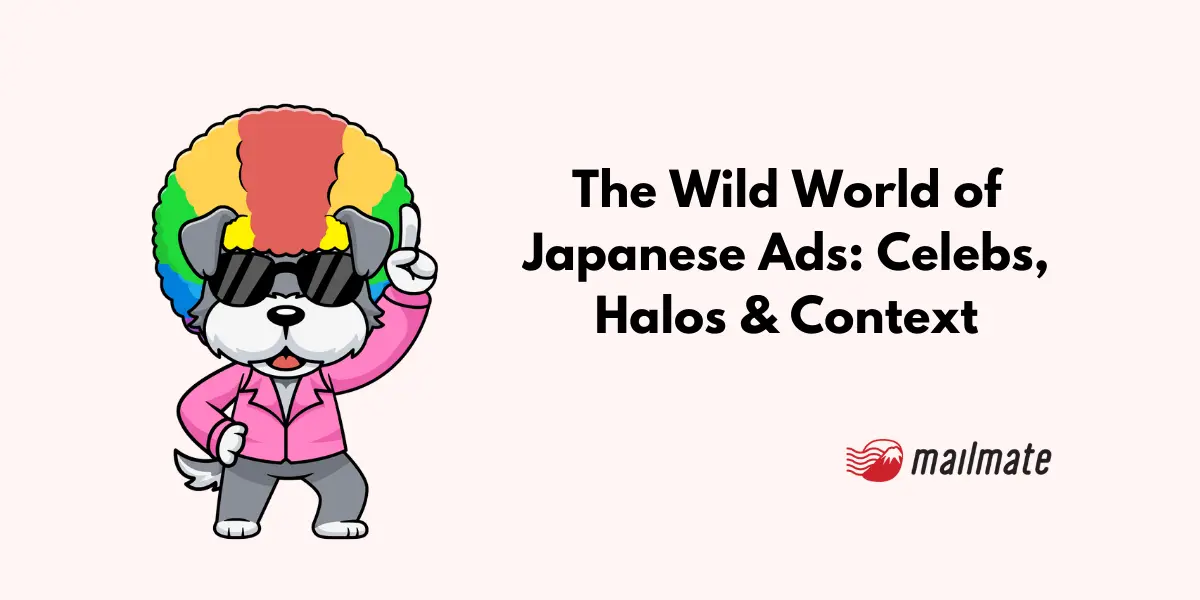The Wild World of Japanese Ads: Celebs, Halos & Context

From TV CMs to subway posters and magazine inserts—Japanese ads are rich in variety. Some arrest the senses with outlandish sets and explosive designs. Some are softer in their approach with minimalist scenes of nature, animals, and everyday life.
Yet, one commonality penetrates the broad range of Japanese ad strategy: celebrity power.
Japanese businesses love using celebrities so much, it can be challenging to find adverts not featuring one. They are not wrong in using this technique.
A survey with 800 respondents from Tokyo (400) and Osaka (400) conducted by KK ASMARQ (2020) reveals just how much consumers in the two metropolitan cities want to watch and see celebrities in their ads.
When asked what they would like to see in an advertisement, celebrities took first place (Tokyo 44.3%, Osaka 47.0%), beautiful scenery came second (Tokyo 32.8%, Osaka 29.8%), and animals third (Tokyo 27.8%, Osaka 28.0%).
Is there a strategy at play? We take a look.
The importance of being modest
Japanese culture considers modesty a virtue. Therefore, excessive deliberating on product value and how it compares against competing products comes off as obnoxious, boasting, or prideful. This is where US ad strategy differs widely from ad strategy in Japan.
A typical Western-style marketing approach centers on highlighting the benefits of a product and then connecting those benefits to core human desires—an approach penetrating Japan's ads, too, albeit slowly.
Compared to businesses in Western cultures, Japanese companies are more reserved in explaining their products in marketing campaigns. And Japanese brands use celebrities in their ad strategy to advertise their products without having to directly discuss a product's benefits.
According to Tomohiro Doai, marketing director of Coca-Cola Japan for 3 years and current managing director of Twentieth Century Fox's Japanese division, Japanese companies will use the celeb-halo effect so their brand will gain recognition by association, thereby avoiding the need for blatant self-praise.
The celeb-halo effect explained
When consumers see a celebrity they admire in an ad, their positive feelings for the celebrity are transferred onto the endorsed brand or commercial product, creating automatic trust and goodwill toward it, even if scant information is shown about the product.

Image. Members of Arashi, a hugely popular band, in a nationwide advertising campaign for Softbank
Thus, celebrity endorsement remains one of the most effective ways to attract consumer attention in Japan.
Additionally, a celebrity endorsing a product provides brands with a ready-made following willing to try whatever the celeb is advertising. We discussed the bandwagon effect in Japan and how "strength in numbers" influences consumer behavior in a previous article.
However, there are dangers to this marketing method: unwise casting may backfire. When you choose to hire celebrities to endorse your brand or product, you entangle your brand's image with the celebrity's reputation. A public fall from grace might be your brand's undoing.
There's another reason Japanese ads can seem confusing to a Western audience…
High-context ads and what that looks like
Japanese marketing is said to be high-context and American marketing low-context. Here's what that means.
High-context marketing seeks to establish emotional and memorable connections through powerful imagery and other poignant means. It relies on the consumers' ability to sense the right feelings about the product and the brand.
Low-context marketing goes straight to the point and leaves little space for ambiguity and clutter. It employs clear and precise methods to relay additional information about the benefits of purchasing a product and why and how the brand surpasses the competition.
Take a look at some features of high-context and low-context marketing.
High-context characteristics
Large photos
Vivid colors
Aggressively cute imagery
Celebrity endorsement
Catchy music
Stylized language
Low-context characteristics
More words
Straightforward copywriting
Clean design
Strong call-to-action
Clear image of the product
You've likely heard or seen some of Japan's many offbeat and outrageous video CMs, as there are many websites and YouTube channels dedicated to their appreciation.
Japanese commercials' visuals are often entirely irrelevant to the product or service, but that doesn't matter. See it once, and you cannot unsee it. This is the effect of high-context marketing.
But not all high-context advertisements rely on shock value.
The minimalistic style of the traditional Japanese arts can also be seen as high-context, identifiable by soft and elegant colors, generous blank spaces, blurry backgrounds, crisp foreground, and the peaceful ambient BGM, altogether communicating the spirit of Zen—yet another form of high-context marketing.
The creative work these advertisers predominantly focus on capturing is the essence of the product and fostering positive and lasting impressions of the brand, product, or services through indirect but consequential ways.
This high-context marketing style juxtaposes with the more logical, assertive, up to date, and upfront Western marketing approach that communicates product value and benefits with unabashed clarity.
What approach is most effective?
When making an advert for a Japanese audience, a measured mix of both approaches is necessary.
The high-context style may be adept at creating memorable connections but lacks a solid call to action. Use high-context marketing tactics to ignite the right feels in your Japanese customers and incorporate a low-context (e.g., direct call-to-action) approach to ensure customer conversion.
Understanding cultural differences in ad strategy will help you plan effectively. But there's more to cover here. Check out this article on advertising laws everyone ought to know about for anyone selling anything in Japan.
Frequently asked questions about Japanese commercials
Why are Japanese ads so weird?
Japanese ads often seem "weird" to Western audiences because they employ a high-context marketing style. This approach seeks to establish emotional and memorable connections through powerful imagery and other poignant means, rather than directly stating the benefits of the product. The visuals in these ads may seem entirely irrelevant to the product or service, but they're designed to be unforgettable. This is the effect of high-context marketing.
Why do Japanese ads use celebrities?
Japanese ads frequently use celebrities as part of their marketing strategy. The positive feelings consumers have for a celebrity can be transferred onto the endorsed brand or commercial product, creating automatic trust and goodwill toward it. This is known as the celeb-halo effect. Additionally, a celebrity endorsement provides brands with a ready-made following willing to try whatever the celeb is advertising.
What are some characteristics of Japanese ads?
Japanese ads, being high-context, often feature large photos, vivid colors, aggressively cute imagery, celebrity endorsements, catchy music, and stylized language. They aim to capture the essence of the product and foster positive and lasting impressions of the brand, product, or services through indirect but consequential ways.
How do Japanese ads differ from Western ads?
Japanese ads, which are high-context, differ significantly from Western, or low-context, ads. While Japanese ads rely on consumers' ability to sense the right feelings about the product and the brand, Western ads are more straightforward, employing clear and precise methods to relay additional information about the benefits of purchasing a product and why and how the brand surpasses the competition.
What is the most effective approach for advertising in Japan?
A measured mix of high-context and low-context approaches is necessary when advertising for a Japanese audience. High-context marketing tactics can ignite the right feelings in Japanese customers, and incorporating a low-context approach, such as a direct call-to-action, can ensure customer conversion. Understanding cultural differences in ad strategy can help plan effectively.
In closing
In closing, the world of Japanese advertising is a fascinating blend of cultural nuances, celebrity influence, and high-context storytelling. It's a world that can seem strange and confusing to outsiders, but once you understand the underlying strategies and cultural influences at play, it becomes a rich tapestry of creativity and innovation.
Whether you're a marketer looking to break into the Japanese market, or simply a curious observer, understanding the unique characteristics of Japanese ads can offer valuable insights into the country's consumer culture. It's a testament to the power of advertising not just as a sales tool, but as a reflection of societal values and cultural norms.
So the next time you come across a Japanese ad that leaves you scratching your head, take a moment to appreciate the strategy behind the spectacle. You might just find that there's more to it than meets the eye.
Spending too long figuring out your Japanese mail?
Virtual mail + translation services start at 3800 per month. 30-day money-back guarantee.

